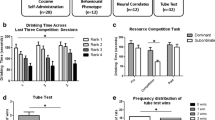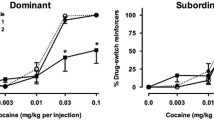Abstract
The influences of social status on amphetamine-induced behavioral effects in squirrel monkeys were investigated. Social status was determined by constructing a sociogram. d-Amphetamine (0.3–1.0 mg/kg orally, 0.3 and 0.6 mg/kg IM) increased stereotyped head movements and reduced the time spent in the sitting posture in all monkeys (N=25) regardless of sex, age, or social status. The high levels of locomotor activity in dominant and juvenile monkeys were decreased at higher amphetamine doses (0.6 mg/kg IM, 0.6 and 1.0 mg/kg orally), whereas the same doses increased locomotion in otherwise less active subdominant and submissive animals. Low doses of amphetamine (0.1, 0.3 mg/kg) decreased the incidence of agonistic behavior initiated by dominant monkeys, and higher doses (0.6, 1.0 mg/kg) caused these monkeys to change from predominant initiators of agonistic behavior into recipients. At 2 h after amphetamine administration (0.3 mg/kg IM), the high levels of locomotor behavior had returned to baseline, the social isolation began to disappear, and the disrupted agonistic behavior of dominant monkeys returned to control levels, yet the stereotyped head movements continued to occur with high frequency. In half of the monkeys, amphetamine produced a large increase in distress-like vocalizations. Amphetamine-mediated motor stereotypies may be mediated by mechanisms different than those responsible for agonistic behavior. The selective changes in agonistic behavior by dominant monkeys when challenged with amphetamine may reflect a status-related functional alteration of catecholaminergic processes upon which the drug acts.
Similar content being viewed by others
References
Altmann J (1974) Observational study of behavior: Sampling methods. Behaviour 49:227–267
Crowley TJ, Stynes AJ, Hydinger M, Kaufman IC (1974) Ethanol, methamphetamine, pentobarbital, morphine, and monkey social behavior. Arch Gen Psychiatry 31:829–838
Dews PB, Wenger GR (1977) Rate-dependency of the behavioral effects of amphetamine. In: Thompson T, Dews PB (eds) Advances in behavioral pharmacology, vol 1. Academic, New York, pp 167–227
Fibiger HC (1978) Drugs and reinforcement mechanisms: A critical review of the catecholamine theory. Annu Rev Pharmacol Toxicol 18:37–56
Garver DL, Schlemmer Jr RF, Maas JW, Davis JM (1975) A schizophreniform behavioral psychosis mediated by dopamine. Am J Psychiatry 132:33–38
Haber S, Barchas PR, Barchas JD (1977) Effects of amphetamine on social behaviors of rhesus macaques: An animal model of paranoia. In: Hanin I, Usdin E (eds) Animal models in psychiatry and neurology. Pergamon, New York, pp 107–115
Haber S, Barchas PR, Barchas JD (1981) A primate analogue of amphetamine-induced behaviors in humans. Biol Psychiatry 16:181–196
Hennessy MB, Coe CL, Mendoza SP, Lowe EL, Levine S (1978) Scent marking and olfactory investigatory behavior in the squirrel monkey (Saimiri sciureus). Behav Biol 24:57–67
Hopf S, Hartmann-Wiesner E, Kühlmorgen B, Mayer S (1974) The behavioral repertoire of the squirrel monkey (Saimiri). Folia Primatol (Basel) 21:225–249
Iversen SD (1977) Brain dopamine systems and behavior. In: Iversen LL, Iversen SD, Snyder SH (eds) Handbook of psychopharmacology, vol 8. Plenum, New York, pp 333–384
Kelly PH (1977) Drug-induced motor behavior. In: Iversen LL, Iversen SD, Snyder SH (eds) Handbook of psychopharmacology, vol 8. Plenum, New York, pp 295–331
Krsiak M, Sulcova A, Tomasikova Z, Dlohozkova N, Kosar E, Masek K (1981) Drug effects on attack, defense and escape in mice. Pharmacol Biochem Behav (Suppl) 14:47–52
Lyon M, Robbins TW (1975) The action of central nervous system stimulant drugs: A general theory concerning amphetamine effects. Curr Dev Psychopharmacol 2:80–142
Miczek KA (1983) Ethopharmacology of aggression, defense, and defeat. In: Simmel EC, Hahn ME, Walters JK (eds) Aggressive behavior: Genetic and neural aspects. Lawrence Erlbaum, Hillsdale NJ, pp 147–166
Miczek KA (1981) Pharmacological evidence for catecholamine involvement in animal aggression. Psychopharmacol Bull 17:60–62
Miczek KA, Barry III H (1976) Pharmacology of sex and aggression. In: Glick SD, Goldfarb J (eds) Behavioral pharmacology. Mosby, St Louis, pp 176–257
Miczek KA, Woolley J, Schlisserman S, Yoshimura H (1981) Analysis of amphetamine effects on agonistic and affiliative behavior in squirrel monkeys (Saimiri sciureus). Pharmacol Biochem Behav (Suppl) 14:103–107
Miczek KA, Yoshimura H (1982) Disruption of primate social behavior by d-amphetamine and cocaine: Differential antagonism by antipsychotics. Psychopharmacology 76:163–171
Nielsen EB, Lyon M (1982) Behavioral alterations during prolonged lowlevel continuous amphetamine administration in a monkey family group (Cercopithecus aethiops). Biol Psychiatry 17:423–435
Poignant JC, Avril A (1978) Pharmacological studies on drugs acting on social behaviour of squirrel monkey: Effects of amineptine, piribedil, d-amphetamine and amitriptyline. Arzneimittelforsch 28:267–271
Randrup A, Munkvad I (1970) Biochemical, anatomical and psychological investigations of stereotyped behavior induced by amphetamines. In: Costa E, Garattini S (eds) Amphetamines and related compounds. Raven, New York, pp 695–713
Raleigh MJ, Brammer GL, McGuire MT (1983) Male dominance, serotonergic systems, and the behavioral and physiological effects of drugs in vervet monkeys. In: Miczek K (ed) Ethopharmacology: Primate models of neuropsychiatric disorders. Alan R. Liss, New York, in press
Schiørring E (1977) Changes in individual and social behavior induced by amphetamine and related compounds in monkeys and man. In: Ellinwood EH, Kilbey M (eds) Cocaine and other stimulants. Plenum, New York, pp 481–522
Schiørring E (1979) Social isolation and other behavioral changes in groups of adult vervet monkeys (Cercopithecus aethiops) produced by low, nonchronic doses of d-amphetamine. Psychopharmacology 64:297–302
Schiørring E (1981) Psychopathology induced by ‘speed-drugs’. Pharmacol Biochem Behav (Suppl) 14:109–122
Schlemmer Jr RF, Casper RC, Siemens FK, Garver DL, Davis JM (1976) Behavioral changes in a juvenile primate social colony with chronic administration of d-amphetamine. Psychopharmacol Commun 2:49–59
Schlemmer Jr RF, Davis JM (1981) Evidence for dopamine mediation of submissive gestures in the stumptail macaque monkey. Pharmacol Biochem Behav (Suppl) 14:95–102
Scraggs PR, Ridley RM (1978) Behavioural effects of amphetamine in a small primate: Relative potencies of the d and l isomers. Psychopharmacology 59:243–245
Scraggs PR, Ridley RM (1979) The effect of dopamine and noradrenaline blockade on amphetamine-induced behaviour in the marmoset. Psychopharmacology 62:41–45
Seiden LS, MacPhail RC, Oglesby MW (1975) Catecholamines and drug-behavior interactions. Fed Proc 34:1823–1831
Winter P (1968) Social communication in the squirrel monkey. In: Rosenblum LA, Cooper RW (eds) The squirrel monkey. Academic, New York, pp 235–253
Wise RA (1981) Brain dopamine and reward. In: Cooper SJ (ed) Theory in psychopharmacology, vol 1. Academic, London, pp 103–122
Author information
Authors and Affiliations
Rights and permissions
About this article
Cite this article
Miczek, K.A., Gold, L.H. d-Amphetamine in squirrel monkeys of different social status: Effects on social and agonistic behavior, locomotion, and stereotypies. Psychopharmacology 81, 183–190 (1983). https://doi.org/10.1007/BF00427259
Received:
Accepted:
Issue Date:
DOI: https://doi.org/10.1007/BF00427259




